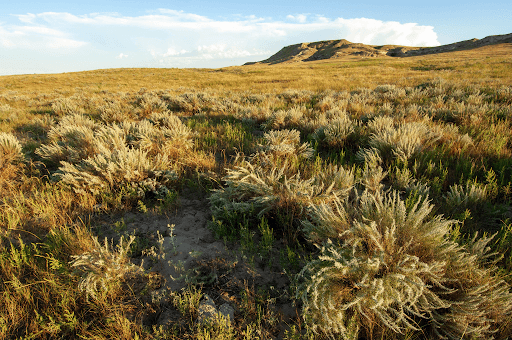
Nebraska’s natural beauty is often overlooked, but its prairies hold profound historical and ecological significance. These vast grasslands thrived long before the arrival of Native Americans, sustaining bison and serving as the foundation for agriculture and settlement. The prairie has played a vital role in making Nebraska the state it is today.
Nebraska is undeniably a prairie state, though this fact is often forgotten, with scientists estimating that nearly 80% of the prairie ecosystems have disappeared.
But what exactly is a prairie? The term "prairie" comes from the French word for "meadow" and describes North America's largest grassland biome.
Prairie landscapes are characterized by moderate temperatures, seasonal rainfall and sparse tree cover. Prairies and grasslands are among the most endangered ecosystems on the planet. These biomes are home to a remarkable level of biodiversity, comparable to, or even exceeding, that of rainforests and coral reefs. However, maybe the reason this is often overlooked is because much of this biodiversity is concentrated beneath the soil’s surface.
Prairies are shaped by rainfall patterns. As the Rocky Mountains rose, they created a rain-shadow effect, blocking moisture from the west and limiting precipitation. This scarcity of water hindered tree growth, allowing grasslands and prairie ecosystems to take root instead.
The Historical Roots of Nebraska's Prairies
Indigenous peoples have inhabited what is now Nebraska for thousands of years. The historic tribes of the region included the Omaha, Missouria, Ponca, Pawnee, Otoe, and several branches of the Lakota (Sioux), with some of these groups migrating westward from eastern regions.
Before European exploration, the population density was low, with around one person for every 5,000 acres of grassland. Native Americans hunted bison, pronghorn antelope, deer, and elk, using animal hides for clothing and shelter, while also gathering native plants. Some built homes from prairie grasses.
Their connection to the land was spiritual. They believed trees spoke to them, animals were their siblings, the sky their father, and the earth their mother. This bond lasted for about 10,000 years before Europeans arrived.
With the passage of the Homestead Act of 1862, thousands of new settlers moved to Nebraska to claim free land offered by the federal government. With few trees available, many of the early settlers built their homes from sod, much like the Native Americans, including the Omaha.
Between the 1870s and 1880s, Nebraska saw rapid population growth, driven by the suitability of the prairie for cattle grazing and the rise of new farming technologies. Agriculture, ranching, and urbanization transformed the prairies dramatically.
The Types of Nebraska’s Prairies
Nebraska's prairies vary from east to west, each region with its own distinct ecosystem, wildlife, plant species, and climate. These regions, known as ecoregions, are: tallgrass prairie, mixed-grass prairie, shortgrass prairie, and the Sandhills.
Early explorers described the tallgrass prairie as a vast sea of grass, with wide-open skies and a wealth of wildflowers growing in fertile soil. In Nebraska, the Tallgrass Prairie Ecoregion spans the eastern quarter of Nebraska and receives 25–36 inches of rainfall annually, making it the wettest ecoregion in the state. It includes parts of two major Nebraska rivers: the Missouri and the Platte.
- Characteristics: Tall grasses like big bluestem, switchgrass, Indian grass, and a variety of wildflowers.
- Where it is found: Predominantly in Eastern Nebraska.
- Ecological importance: Supports wildlife such as bison, prairie chickens, and various bird species, including those migrating along the Missouri River.
Located between the tallgrass prairie to the east and the shortgrass prairie to the west, the Mixed Grass Prairie Ecoregion blends features from both. It receives between 20 and 28 inches of rainfall annually and contains a diverse mix of rivers, wetlands, and floodplains.
- Characteristics: A mixture of tall grasses and shorter grasses like blue grama and buffalo grass.
- Where it is found: Central Nebraska.
- Ecological importance: Home to a wide variety of plants and animals, including insects, small mammals like the white-tailed jackrabbit, and over two dozen species of migratory waterfowl. Notably, the Rainwater Basin wetlands in this region host one-third of the continent’s northern pintails, 50% of its mallards, and over 90% of the mid-continent’s greater white-fronted geese.
The sandhills remain one of the last largest remaining areas of the Great American Plains. This geologically young region has formed over the past 13,000 years, shaped by droughts and shifting sand dunes. The climate is semiarid, with rainfall ranging from 23 inches in the east to under 17 inches in the west.
Beneath the dunes lies the Ogallala aquifer, one of the world’s largest underground water reserves, providing water to nearly 2,000 shallow lakes and over a million acres of wetlands.
- Characteristics: A mixture of sand-adapted grasses including sand bluestem, prairie sandreed, little bluestem, and hairy grama.
- Where it is found: North-central Nebraska.
- Ecological importance: Spanning 19,300 square miles, the Sandhills is the largest stabilized dune system in the Western Hemisphere and one of the biggest intact native grasslands in North America. It's home to a rich variety of plant communities, mammals, insects, and migratory birds.
This region features a mix of landscapes, including rocky escarpments, sand prairies, and pine woodlands. The climate is arid, with rainfall ranging from 12 to 17 inches annually. Plants here are adapted to dry conditions, with grasses like buffalo grass and blue grama dominating the landscape.
- Characteristics: Short grasses such as blue grama and western wheatgrass.
- Where it is found: Western Nebraska, in drier, less fertile areas.
- Ecological importance: Provides habitat for species like pronghorn antelope and prairie dogs, adapted to arid conditions.
Bison: Keystone Species of the Prairie
No discussion of Nebraska’s prairies would be complete without mentioning the American bison, a keystone species in this ecosystem. Historically, massive herds of bison shaped the landscape, influenced plant growth, and supported a range of animals. Bison were also a vital resource for Native Americans, providing food, clothing, and tools.
Unfortunately, bison populations were nearly wiped out after European settlers arrived. They were hunted for their meat and to make way for agriculture and urban development. Today, bison are making a comeback, though their populations are still a fraction of what they once were. There are currently around 360,000 bison in North America, with about half living on private ranches and farms.
The Role of Fire in Prairie Ecology
Fire plays a critical role in maintaining prairie ecosystems. It prevents the encroachment of woody plants, helps seeds germinate, and promotes plant growth. Fire also produces more nutritious vegetation for grazers like bison. Natural fires, caused by lightning or indigenous practices, have shaped the Tallgrass Prairie for thousands of years. Historically, fires would burn vast areas every 3-6 years.
Today, land managers use prescribed burning to mimic the natural fires that once maintained prairie ecosystems. This controlled process involves intentionally setting fires at specific times and conditions chosen by the manager. Key decisions include what to burn, when, and how often, based on knowledge of historic fire patterns. Because fire effects can vary by location, these decisions differ from place to place, and there’s still much to learn about the best practices.
Objectives, or desired future conditions, help determine the right fire conditions needed to achieve desired outcomes, as fire affects plant species differently. The timing, intensity, and frequency of fires shape vegetation, community structure, and plant diversity. Prescribed burning benefits fire-adapted plants while limiting those that aren't. Since fire alone doesn’t always meet management goals, other methods like interseeding, grazing, or spraying may also be needed. Without fire, dead plant buildup and woody encroachment degrade grasslands.
Conservation Efforts and Challenges
Tallgrass prairies once covered 170 million acres of the Great Plains, including much of eastern Nebraska. Today, farming and development have reduced this coverage by 98% to 99%, leaving only small remnants of what was once a vast ocean of grass. Within Nebraska’s four prairie ecoregions, 83 natural plant communities remain, such as eastern sedge wet meadows and sand sage prairie. Therefore, conserving these areas is vital.
Efforts to restore and protect Nebraska’s prairies are ongoing. Organizations like The Nature Conservancy and the Prairie Plains Resource Institute are leading restoration and conservation initiatives:
- The Nature Conservancy (TNC) focuses on land protection and sustainable farming practices around the Platte River
- Prairie Plains Resource Institute works on rebuilding prairies in areas where they’ve been lost.
The prairies of Nebraska are resilient, but their continued health depends on active conservation efforts. Preserving these ecosystems is essential for maintaining biodiversity and supporting the wide array of native species that rely on the prairie.
As Willa Cather, an American writer from the Plains, once said, “Anybody can love the mountains, but it takes a soul to love the prairie.”
To learn more about where to explore Nebraska’s prairies, check out the Great Plains Ecotourism Coalition’s Visit the Prairie Page.
Check out our past webinars below or on the Conservation YouTube Channel:
Restoring the Great Plains Prairie

